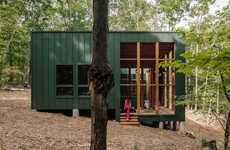The 'House in the Outskirts of Brussels' by Philippe Samyn and Partners is a single family residence in Belgium. The facade originally was covered with ivy, but botanical artist Patrick Blanc completely covered the wall and roof with a large range of foreign vegetation and exotic plants.
The building’s facade is completely covered in grass, moss and ferns, and the only visible materials are the glass windows. This house is perfect for a large family with its five children’s rooms, sanitary area, large living room, kitchen and family room.
The back of the house is made completely out of glass with a geometric pattern. This odd and distinctly designed house blends into the scenery from the front, and is transparent in the back.
Plant-Covered Camouflaging Havens
The 'House in the Outskirts of Brussels' is by Philippe Samyn
Trend Themes
1. Botanical Architecture - The use of vegetation to completely cover buildings presents an opportunity for architects and designers to create environmentally-friendly and visually striking structures.
2. Sustainable Housing - The integration of plants and greenery into residential architecture not only enhances the aesthetics but also offers potential for energy-saving and sustainable living.
3. Biophilic Design - The incorporation of natural elements, such as plants, into architectural design can improve human well-being and productivity, offering opportunities for designers to create healthier and more productive spaces.
Industry Implications
1. Architecture - Architects can explore the concept of botanical architecture to create innovative and sustainable building designs.
2. Interior Design - Interior designers can incorporate the principles of biophilic design to bring the benefits of nature indoors, creating healthier and more appealing spaces.
3. Real Estate - Real estate developers can leverage the trend of sustainable housing to attract environmentally-conscious homeowners and create unique selling points for their properties.






